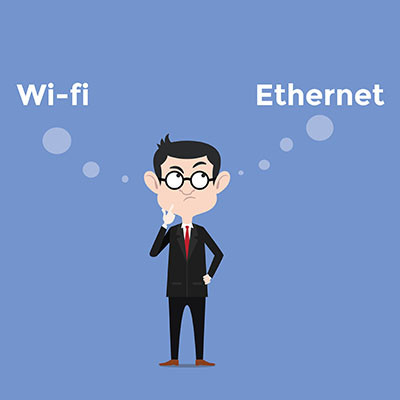WatchPoint Solutions Blog
Are Hardwired or Wireless Connections Better?
Not long ago, connectivity required an actual, physical connection between two endpoints. As a result, a wired connection was the only option for businesses to access online materials and resources. Today, businesses have a choice to make: is a wired connection better for my operations, or should I implement wireless connectivity?
Today, we’ll compare some of the relative strengths and weaknesses of wired and wireless connections to see what we can learn.
The Benefits of a Hardwired Connection
- Speed - When comparing the two, wired connections are far faster than a wireless one. With the advantage both in terms of transferring data within your network as well as to the Internet, an Ethernet connection is clearly the more efficient transmission medium.
- Stability - As a cable needs to come unplugged in order for you to lose a wired connection, it is safe to say that they are also far more stable than a wireless connection is, which means that devices using a wired connection have more consistent speeds with the reduced risk of external influence.
- Security - Obviously, a direct connection between two network points is going to be more secure than wireless signals broadcast through the air, ready for anyone to potentially intercept them.
The Benefits of a Wireless Connection
- Mobility - When using a Wi-Fi connection, there are no wires connecting a user in one place. The practical benefits of implementing this can make a great difference in the workplace, enabling productivity and collaboration from effectively anywhere. With the right workstations, your employees can work from their desk, a conference room, or basically anywhere the connection’s broadcast allows.
- Scope - Wireless Internet also enables your team to work from a wider variety of devices, a big help in today’s increasingly mobilized business environment. Wi-Fi can also be used to enable those external to your business to access the Internet on their own devices, so public-facing businesses often make this a perk for their clients.
- Convenience - When you don’t need to be tied to a network port, accessing the Internet is far more convenient than the alternative. Communication and collaboration are driven by increased accessibility, and a wireless network can provide just that.
A Hybrid Approach May Offer Maximum Benefits
There is nothing that says that a business can’t embrace both means of connectivity to get the most out of its network’s capabilities. In doing so, your organization can cancel out the weaknesses that either option presents. It really depends on your business’ needs and your employees’ demands.
WatchPoint Solutions can help you with your business’ IT, from your connectivity to the components you’re connecting. Give one of our IT professionals a call today at (848) 202-8860.

Comments